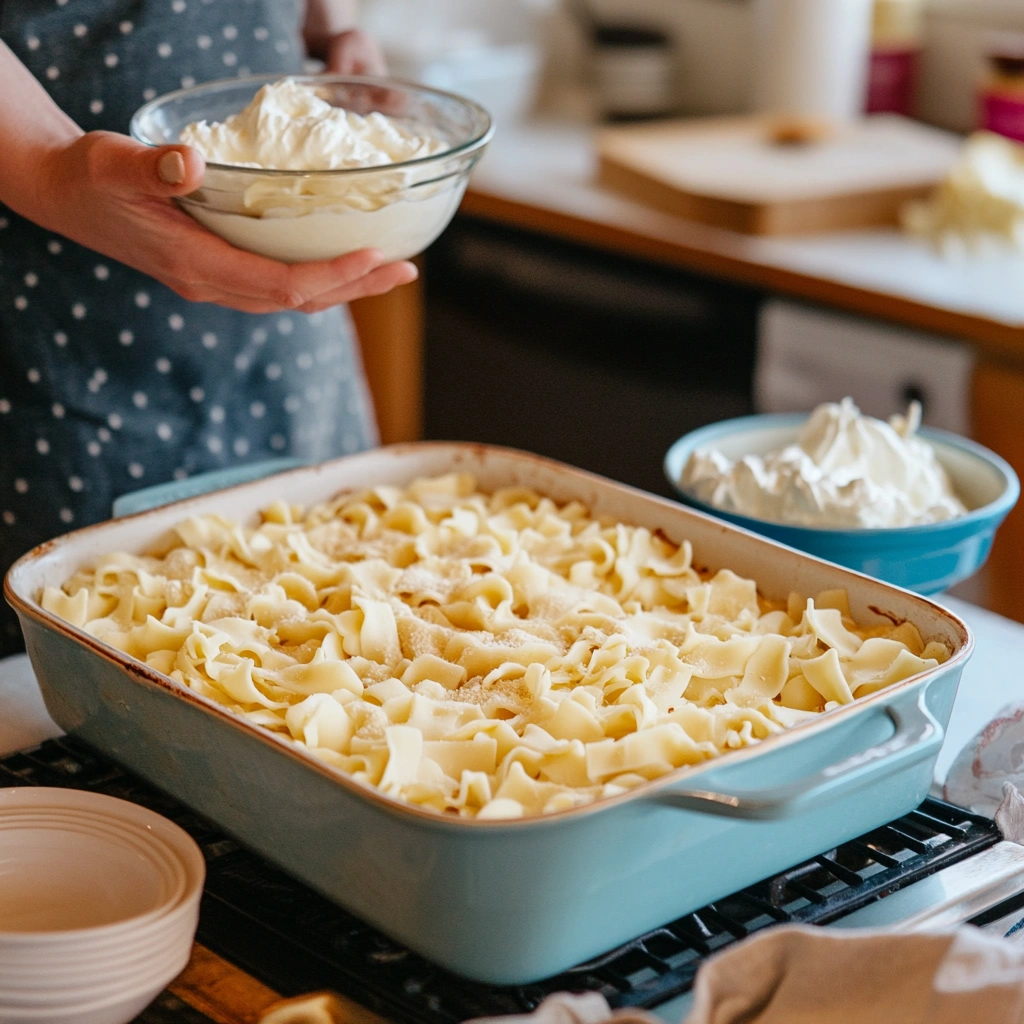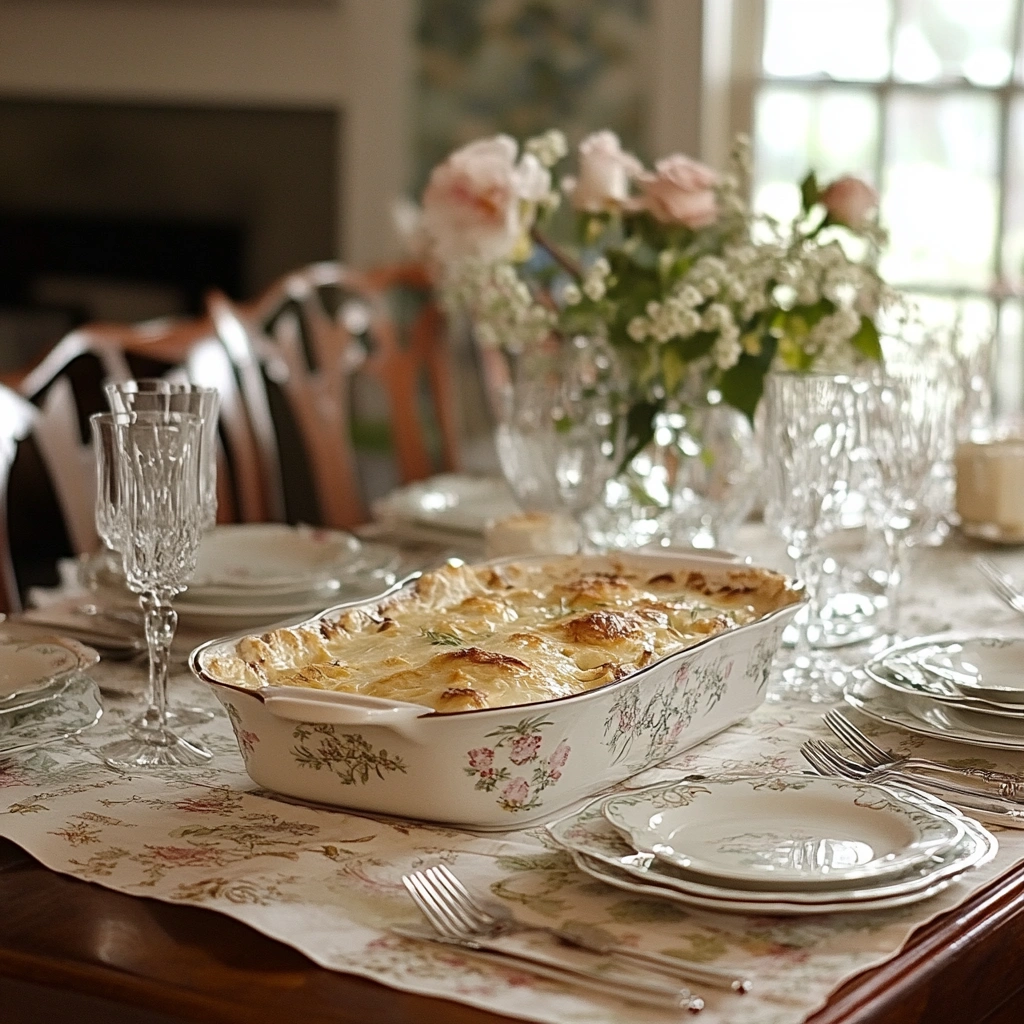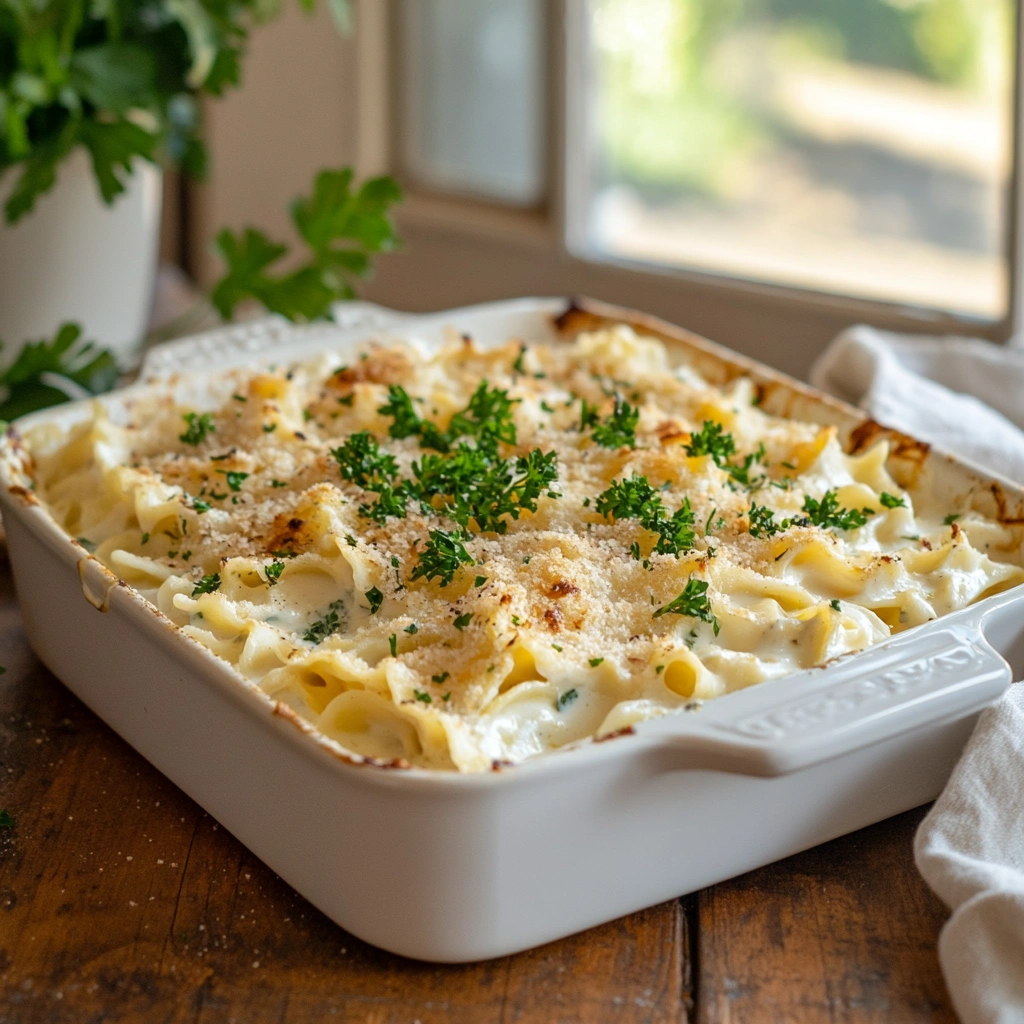What is Jackie Kennedy Casserole?
If you’re a fan of vintage recipes and a touch of culinary history, you might have stumbled upon the question: What is Jackie Kennedy casserole? This iconic dish, linked to one of America’s most admired First Ladies, offers a unique glimpse into mid-century dining trends. A combination of creamy, comforting ingredients and elegant simplicity, this casserole reflects the sophistication of Jacqueline Kennedy, a woman who defined style, grace, and poise in everything she did—including food. But what exactly is this casserole, where did it come from, and why does it still captivate food lovers today? Let’s dig into its origins, recipe, and timeless charm.
Part 1: Introduction to Jackie Kennedy Casserole
Definition and Overview
At its core, Jackie Kennedy casserole, often called Casserole Marie Blanche, is a classic mid-20th-century dish. Featuring layers of creamy noodles, cottage cheese, and sour cream, it embodies both comfort and elegance. This dish became renowned for its subtle flavors, simple preparation, and adaptability for different occasions. The recipe reflects the understated, refined tastes of the Kennedy family kitchen during their time in the White House.
Though this casserole isn’t widely mentioned in modern cookbooks, it serves as a nostalgic relic of 1960s American cuisine. Unlike heavy, complicated casseroles, Jackie Kennedy’s version exudes an air of lightness—perfectly in line with her elegant reputation. The balance of rich dairy products and delicate textures makes it memorable yet approachable, which might explain why it became such a favorite during her era.
Historical Context and Significance
To understand Jackie Kennedy casserole, it’s essential to look at the broader culinary landscape of the early 1960s. Following World War II, American households embraced casseroles for their convenience, versatility, and ability to feed families on a budget. While many recipes relied on canned soups and processed ingredients, Jackie Kennedy brought sophistication to this beloved comfort food.
The dish’s association with Jacqueline Kennedy lends it a certain prestige. As a First Lady admired worldwide, Jackie Kennedy was not only a style icon but also a trendsetter in the kitchen. Unlike other public figures, she preferred meals that were simple yet refined, perfectly balancing French influences—from her time living in Europe—with the practicality of American home cooking.
During her time in the White House, Jackie became known for revitalizing events and dinners with thoughtful menus. This casserole, though humble, likely made appearances at casual meals or informal family gatherings. It represented an ideal blend of tradition and modern tastes, something she often achieved in her approach to public life.
By introducing dishes like Casserole Marie Blanche to American tables, she showcased the elegance of simplicity. Over time, this recipe became more than just a meal—it became part of her enduring legacy. Even today, food historians and enthusiasts are fascinated by how something so seemingly ordinary became so culturally significant.
Part 2: Origins and History of the Casserole
Jackie Kennedy’s Influence on American Cuisine
Jacqueline Kennedy, often simply known as Jackie, brought a remarkable blend of sophistication and practicality to the White House. Her influence on American cuisine during the 1960s cannot be overstated. Known for her impeccable taste in fashion, decor, and entertaining, Jackie also had a distinct influence on food trends. Her time spent in Europe, particularly in France, introduced her to refined flavors and simple yet elegant dishes.
However, Jackie was not one to flaunt extravagance unnecessarily. Unlike other First Ladies who may have preferred heavy, labor-intensive meals, Jackie Kennedy embraced dishes that were approachable, light, and flavorful. The Jackie Kennedy casserole, often referred to as Casserole Marie Blanche, reflected this balance perfectly. It was simple enough for everyday dining but still refined enough to be served to distinguished guests.
The Kennedy family’s dining habits quickly became a matter of public interest. Americans admired Jackie not only for her grace but also for her ability to make even the most casual meals feel special. This casserole became an extension of her personality—practical yet polished, familiar yet elegant.
The Creation of Casserole Marie Blanche
The origins of Casserole Marie Blanche can be traced back to Jackie Kennedy’s desire to combine European simplicity with American practicality. Unlike the traditional casseroles of the time, which often relied on canned soups and overly processed ingredients, this recipe was designed to feel homemade and wholesome. The dish reportedly consisted of layers of soft noodles, rich cottage cheese, sour cream, and a dash of seasoning.
The name “Marie Blanche” adds an air of French sophistication, though its exact source remains somewhat unclear. Some culinary historians suggest that the name was chosen simply to evoke refinement and simplicity—qualities that Jackie admired in French cuisine. Others speculate that “Marie Blanche” could refer to a beloved family recipe or even a personal favorite dish Jackie encountered during her travels.
What sets this dish apart is its minimalist approach. With just a handful of ingredients, Jackie Kennedy casserole manages to deliver a rich, comforting flavor without overwhelming the palate. This simplicity was revolutionary at a time when many American meals were becoming increasingly heavy and complex.
Notable Occasions Featuring the Dish
While Jackie Kennedy’s formal White House dinners were often lavish affairs featuring multiple courses, Casserole Marie Blanche likely made appearances during more intimate gatherings. The dish’s simplicity made it a perfect choice for casual meals with close family and friends. It’s easy to imagine the Kennedy family sitting around a table enjoying this comforting, creamy casserole.
Jackie’s focus on understated elegance extended beyond formal occasions. For family meals, she often preferred dishes that could be prepared easily without sacrificing taste or quality. This casserole, with its few ingredients and straightforward preparation, embodied those ideals perfectly.
Though there’s little documented evidence of the dish being served at specific public events, its association with Jackie Kennedy has made it a culinary icon. Over the decades, Jackie Kennedy casserole has remained a nostalgic nod to the First Lady’s sophisticated yet practical approach to food. It represents a time when meals were meant to be savored, shared, and celebrated without unnecessary fuss.
By introducing such simple yet elegant dishes to American tables, Jackie Kennedy redefined what comfort food could be. The casserole became more than just a meal; it became a symbol of how style and substance could coexist beautifully.

Part 3: Detailed Recipe and Preparation
Ingredients List
Creating Jackie Kennedy casserole, often referred to as Casserole Marie Blanche, requires a short yet carefully chosen list of ingredients. Its simplicity is what makes it stand out. Here’s what you’ll need:
- 8 ounces of wide egg noodles (or any soft, flat noodles)
- 1 cup of cottage cheese (preferably full-fat for a creamier texture)
- 1 cup of sour cream
- 1/4 cup of melted butter
- 1/2 teaspoon of salt
- 1/4 teaspoon of black pepper
- A pinch of paprika (for a subtle kick and visual appeal)
- Fresh parsley (optional, for garnish)
What makes this ingredient list unique is the delicate harmony of creamy textures and simple flavors. Unlike modern casseroles that lean heavily on processed additives, Jackie Kennedy’s casserole keeps things wholesome and straightforward.
Step-by-Step Preparation Guide
Preparing this dish is as easy as its ingredient list suggests. Follow these step-by-step instructions to recreate the timeless elegance of Jackie Kennedy casserole:
- Boil the Noodles
Start by bringing a large pot of salted water to a boil. Add the wide egg noodles and cook until they are tender but still firm to the bite (al dente). This should take about 7–8 minutes. Drain the noodles and set them aside to cool slightly. - Combine the Creamy Mixture
In a medium bowl, mix the cottage cheese, sour cream, melted butter, salt, and black pepper. Stir the ingredients together until they form a smooth and creamy blend. Taste the mixture and adjust the seasoning if needed. - Layer the Casserole
Preheat your oven to 350°F (175°C). Lightly grease a baking dish (an 8×8-inch dish works well) with butter or a non-stick spray. Spread half of the cooked noodles evenly across the bottom of the dish. Then, pour half of the creamy mixture over the noodles, spreading it out gently. Repeat with the remaining noodles and cream mixture, ensuring an even layer. - Add the Final Touches
Sprinkle a pinch of paprika across the top of the casserole. Not only does this add a subtle warmth to the flavor, but it also gives the dish an appealing pop of color. - Bake to Perfection
Place the casserole in the preheated oven and bake for 25–30 minutes, or until it’s golden and bubbly around the edges. The top should look slightly set but still soft and creamy in texture. - Garnish and Serve
Remove the casserole from the oven and allow it to cool for a few minutes. For an added touch of elegance, garnish with freshly chopped parsley before serving. This step isn’t necessary, but it adds a burst of freshness and visual appeal.
Cooking Tips and Variations
While the original Jackie Kennedy casserole is a masterpiece of simplicity, you can adapt it to suit your preferences. Here are a few tips and variations:
- Add Vegetables: To make the casserole heartier, consider adding sautéed spinach, mushrooms, or zucchini. These vegetables pair beautifully with the creamy base without overpowering the dish.
- Cheese Variations: Swap cottage cheese for ricotta if you prefer a slightly sweeter, smoother texture. A sprinkle of grated Parmesan on top before baking can also add a nice umami kick.
- Make it Protein-Rich: For a boost of protein, stir in some shredded rotisserie chicken or ground turkey. This transforms the casserole into a complete, satisfying meal.
- Gluten-Free Option: Use gluten-free noodles to accommodate dietary restrictions while preserving the dish’s flavor and charm.
What makes this casserole stand the test of time is its versatility. Whether served as a main dish for dinner or a side at a casual brunch, it always delivers comfort and elegance in equal measure. Plus, it’s a perfect make-ahead dish for busy families. Simply assemble it, refrigerate overnight, and bake when ready to serve.
This recipe’s brilliance lies in its minimalism. In a world of overly complex dishes, Jackie Kennedy casserole reminds us that sometimes, the simplest meals are the most satisfying. It’s no wonder this dish continues to capture the hearts—and appetites—of those who discover its timeless charm.
Part 4: Cultural Impact and Legacy
Popularity in the 1960s and Beyond
The Jackie Kennedy casserole, or Casserole Marie Blanche, became a subtle symbol of mid-20th century American dining culture. During the 1960s, the nation was fascinated with the Kennedy family, and Jackie, in particular, epitomized grace and style. Her culinary preferences influenced countless homemakers who sought to replicate her refined yet accessible taste in their kitchens.
At a time when convenience foods like canned soups and frozen meals were becoming the norm, Jackie’s casserole offered a breath of fresh air. It was light, creamy, and elegant—an antidote to the heavier, overly processed dishes of the era. This casserole reflected the broader cultural movement of the 1960s, where simplicity and sophistication began to intersect in American homes.
Jackie’s preference for approachable yet stylish meals set a trend that many followed. Her casserole, though simple in appearance, became a staple for families who wanted to elevate their dining experiences without fuss. It embodied a sense of refinement that resonated with the era’s changing attitudes toward food and entertaining.

Modern Interpretations and Adaptations
Over the decades, Jackie Kennedy casserole has been adapted to suit modern tastes and dietary needs. Food lovers and chefs alike have taken the original concept and infused it with contemporary twists, while still preserving its nostalgic essence.
- Health-Conscious Variations: Today’s versions often include healthier alternatives, like Greek yogurt in place of sour cream, or low-fat cottage cheese. Whole wheat noodles or gluten-free pasta can also be used to make the dish more accommodating to different lifestyles.
- Flavor Enhancements: While the original casserole leans on minimal seasoning, modern adaptations may add garlic, onions, or fresh herbs like thyme and basil. These small additions enhance the flavor without overshadowing the dish’s simplicity.
- Global Influences: Jackie’s travels in Europe inspired the dish’s French-like name, and today’s cooks are incorporating international flavors. Mediterranean-style casseroles, for example, might include feta, spinach, or olives, nodding to Jackie’s appreciation for European cuisine.
Interestingly, despite its updates, the core of the recipe remains intact. The dish’s timeless quality—creamy noodles layered with subtle flavors—continues to appeal to both nostalgic cooks and new generations discovering it for the first time. It’s a testament to Jackie Kennedy’s enduring influence that this humble casserole remains relevant even in today’s culinary landscape.
The Casserole in Contemporary Cuisine
In modern times, Jackie Kennedy casserole is more than just a dish; it’s a culinary time capsule. For food historians and vintage recipe enthusiasts, recreating this casserole is a way to connect with the past—a period when food was shared at family tables and simplicity was celebrated.
Many home cooks are rediscovering this recipe through blogs, vintage cookbooks, and Kennedy-era retrospectives. Social media platforms have also contributed to its revival, with people sharing their interpretations and experiences with the dish. It’s not uncommon to see Jackie Kennedy casserole pop up in food challenges, themed dinner parties, and retro recipe collections.
The casserole’s versatility also makes it a favorite among today’s busy households. Its ease of preparation, ability to be made ahead of time, and universally appealing flavors align perfectly with modern lifestyles. Whether served at a holiday brunch, a cozy family dinner, or a potluck gathering, the dish continues to shine as an example of timeless comfort food.
Ultimately, Jackie Kennedy casserole represents more than just a recipe—it embodies a unique moment in culinary history. It serves as a reminder of Jackie Kennedy’s influence, her appreciation for life’s simple pleasures, and her ability to inspire elegance in every detail, even in something as humble as a casserole.
Frequently Asked Questions (FAQs)
What is the origin of the name “Casserole Marie Blanche”?
The name Casserole Marie Blanche has French influences, reflecting Jackie Kennedy’s admiration for European culture, particularly French cuisine. While the exact origin of the name remains unclear, it likely adds an air of sophistication to this otherwise simple dish. “Marie Blanche” loosely translates to “white Marie,” which may refer to the creamy and pale color of the casserole itself.
Did Jackie Kennedy personally create this recipe?
While Jackie Kennedy casserole is closely associated with Jacqueline Kennedy’s culinary tastes, there is no definitive evidence that she personally created the recipe. However, it reflects her preference for light, elegant, and approachable dishes, which align perfectly with her refined style. The casserole became a symbol of the understated elegance she brought to the White House kitchen.
Can the casserole be prepared ahead of time?
Yes, Jackie Kennedy casserole is ideal for making ahead of time. Assemble the casserole as directed and refrigerate it overnight before baking. This allows the flavors to meld and makes it a perfect option for busy households or entertaining guests. Simply pop it in the oven when ready to serve, and you’ll have a creamy, comforting dish in no time.
What are some common variations of this dish?
Many modern adaptations of Jackie Kennedy casserole incorporate additional ingredients to suit contemporary tastes. Common variations include adding sautéed spinach, mushrooms, or shredded chicken for extra flavor and texture. Healthier substitutions like Greek yogurt for sour cream or ricotta for cottage cheese are also popular. These tweaks allow the dish to remain versatile while preserving its nostalgic charm.
Is Jackie Kennedy casserole a traditional family recipe?
While it’s often associated with the Kennedy family, Casserole Marie Blanche is not a documented Kennedy heirloom recipe. Instead, it’s more likely a dish inspired by Jackie Kennedy’s preference for simple, European-influenced cuisine. It became famous because of its connection to her elegant yet relatable culinary style.
Can this casserole be served as a side dish or a main course?
Absolutely! The beauty of Jackie Kennedy casserole lies in its versatility. It can be served as a comforting main course, paired with a light salad or roasted vegetables. Alternatively, it works beautifully as a side dish alongside a protein like grilled chicken or turkey. Its creamy and neutral flavors make it a perfect complement to a variety of meals.
Conclusion
The Jackie Kennedy casserole, also known as Casserole Marie Blanche, remains a beautiful blend of simplicity, elegance, and nostalgia. A dish that encapsulates the culinary preferences of one of America’s most iconic First Ladies, it serves as a timeless reminder of Jacqueline Kennedy’s unique ability to infuse sophistication into even the most humble meals.
This casserole, with its creamy layers of cottage cheese, sour cream, and tender noodles, has transcended generations. Whether you’re recreating it for its historical significance, exploring vintage recipes, or seeking comfort food with a touch of refinement, the dish offers a little something for everyone. It’s no wonder it has stood the test of time.
In today’s fast-paced world, the Jackie Kennedy casserole reminds us to savor the simplicity of home-cooked meals shared with loved ones. It’s more than just a recipe; it’s a piece of culinary history, a symbol of style and grace, and a nod to the values of timeless comfort and family togetherness. By bringing this dish to your table, you’re not only honoring Jackie Kennedy’s legacy but also keeping a part of mid-century American culture alive.

